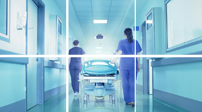Breast cancer is the most frequent cancer among women, impacting 2.1 million women each year, and also causes the greatest number of cancer-related deaths among women. In 2018, it is estimated that 627,000 women died from breast cancer that is approximately 15% of all cancer deaths among women. While breast cancer rates are higher among women in more developed regions, rates are increasing in nearly every region globally.
In order to improve breast cancer outcomes and survival, early detection is critical. There are two early detection strategies for breast cancer: early diagnosis and screening. Limited resource settings with weak health systems where the majority of women are diagnosed in late stages should prioritize early diagnosis program based on awareness of early signs and symptoms and prompt referral to diagnosis and treatment.
Early diagnosis
Early diagnosis strategies focus on providing timely access to cancer treatment by reducing barriers to care and/or improving access to effective diagnosis services. The goal is to increase the proportion of breast cancers identified at an early stage, allowing for more effective treatment to be used and reducing the risks of death from breast cancer.
Screening
Screening consists of testing women to identify cancers before any symptoms appear. Various methods have been evaluated as breast cancer screening tools, including mammography, ultrasonography, MRI and clinical breast exam.
Mammography:
Uses low-energy X-rays to identify abnormalities in the breast. It has been shown to reduce breast cancer mortality by approximately 20% in high-resource settings. WHO Position paper on mammography screening concluded that in well-resourced settings women aged 50-69 should undergo organized, population-based mammography screening if pre-specified conditions on programme implementation are met. In limited resource settings with weak health systems, mammography is not cost-effective, and early detection should focus on reducing stage at diagnosis through improved awareness. Mammography is currently the best available population-based method to detect breast cancer at an early stage, when treatment is most effective.
Clinical Breast Exam (CBE): is an examination of both breasts performed by a trained health professional. CBE seems to be a promising approach for low resource settings and could be implemented depending on the evidence from ongoing studies. But this is inferior to mammography.
So, should I undergo screening, and if yes, when?
To answer this question, you should know whether you fall into an average risk group or high risk group for breast cancer.
Individuals who are at high risk for breast cancer
- Family history of breast cancer
- One or more relatives with breast or ovarian cancer
- Breast cancer occurring in an affected relative younger than 50 years
- Male relatives with breast cancer
- BRCA1 and BRCA2 mutations
- Ataxia-telangiectasia heterozygotes (4 times increased risk)
- Ashkenazi Jewish descent (2 times greater risk; independent of BRCA positivity
- Advanced age
- Suspicious reports in previous breast biopsies
- Personal history of early breast cancer (age less than 40)
- Ionizing radiation exposure before age 30
When to start screening?
Average risk individuals
- Annual mammography from age 45
- Ultrasound may be added to improve the yield
- No role for MRI, unless in doubtful cases
High risk individuals
- Annual MRI screening starting at least from age 30 combined with mammography
There is no evidence currently to suggest that women aged more than 69 years will benefit from breast cancer screening.
Please note that these are general guidelines and you need to visit your doctor for personalized recommendations.
Signs and symptoms of breast cancer
- No symptoms, especially early breast cancer
- Lump in the breast which could be associated with
- Change in breast size or shape
- Skin dimpling or skin changes
- Nipple abnormalities
- Nipple discharge, especially if blood stained
- Axillary lump
Diagnosis
Evaluation includes the following
- Clinical Examination- Examination by your doctor
- Imaging Mammography / Ultrasound / MRI, one or more may be advised depending on the patient
- Needle biopsy / Core biopsy, to confirm the diagnosis
Treatment Options
Management of breast cancer is now so advanced with the advent of newer modalities of treatment like hormone and immunotherapy which are in addition to traditional treatments like surgery, chemotherapy and radiation. It is imperative to understand that the newer modalities are adjuncts and should not be used as primary treatment modalities except in special circumstances. The survival rates of breast cancer has improved dramatically especially in the case of early breast cancers, hence the importance of screening and early detection of breast cancer. Newer techniques of surgery have evolved which doesn’t require complete removal of breast thereby enhancing the quality of life of the patient.

